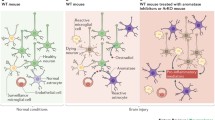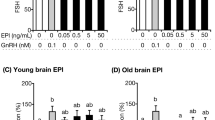Abstract
Depletion of ovarian hormones 17β-estradiol (E2) and progesterone (P) after menopause may contribute to the decline in cognitive performance and increases the risk of Alzheimer’s disease (AD) in women, striking the importance of understanding the regulation of pivotal proteins involved in AD pathogenesis by ovarian hormones. Transthyretin (TTR) is now recognized as one of such proteins due to its ability to sequester and degrade amyloid β (Aβ) into less harmful peptides and preventing their aggregation. We have previously demonstrated that E2 enhances TTR expression. In this study, we investigate the effects of P on TTR expression in primary cultures of rat choroid plexus epithelial cells and in adult ovariectomized female rats. The results obtained demonstrate that, in vitro and in vivo, TTR is up-regulated by P. In addition, the mechanism underlying the response of TTR to P was investigated, and we provide evidence that this response is achieved through a progesterone receptor-mediated mechanism. Our results reinforce the importance of ovarian hormones on the regulation of TTR, which may reflect on the processing of Aβ peptides and consequently on AD onset and progression.




Similar content being viewed by others
References
Brinton RD, Thompson RF, Foy MR et al (2008) Progesterone receptors: form and function in brain. Front Neuroendocrinol 29:313–339
Brouillette J, Quirion R (2008) Transthyretin: a key gene involved in the maintenance of memory capacities during aging. Neurobiol Aging 29:1721–1732
Burger HG, Dudley EC, Robertson DM, Dennerstein L (2002) Hormonal changes in the menopause transition. Recent Prog Horm Res 57:257–275
Carroll JC, Rosario ER, Chang L et al (2007) Progesterone and estrogen regulate Alzheimer-like neuropathology in female 3xTg-AD mice. J Neurosci 27:13357–13365
Costa R, Goncalves A, Saraiva MJ, Cardoso I (2008) Transthyretin binding to A-beta peptide—impact on A-beta fibrillogenesis and toxicity. FEBS Lett 582:936–942
Felding P, Fex G (1982) Cellular origin of prealbumin in the rat. Biochim Biophys Acta 716:446–449
Fleming CE, Saraiva MJ, Sousa MM (2007) Transthyretin enhances nerve regeneration. J Neurochem 103:831–839
Goodman Y, Bruce AJ, Cheng B, Mattson MP (1996) Estrogens attenuate and corticosterone exacerbates excitotoxicity, oxidative injury, and amyloid beta-peptide toxicity in hippocampal neurons. J Neurochem 66:1836–1844
Herbert J, Wilcox JN, Pham KT et al (1986) Transthyretin: a choroid plexus-specific transport protein in human brain. The 1986 S. Weir Mitchell award. Neurology 36:900–911
Kohda K, Jinde S, Iwamoto K, Bundo M, Kato N, Kato T (2006) Maternal separation stress drastically decreases expression of transthyretin in the brains of adult rat offspring. Int J Neuropsychopharmacol 9:201–208
Li MD, Kane JK, Matta SG, Blaner WS, Sharp BM (2000) Nicotine enhances the biosynthesis and secretion of transthyretin from the choroid plexus in rats: implications for beta-amyloid formation. J Neurosci 20:1318–1323
Makover A, Moriwaki H, Ramakrishnan R, Saraiva MJ, Blaner WS, Goodman DS (1988) Plasma transthyretin tissue sites of degradation and turnover in the rat. J Biol Chem 263:8598–8603
Monaco HL (2000) The transthyretin–retinol-binding protein complex. Biochim Biophys Acta 1482:65–72
Mulnard RA, Cotman CW, Kawas C et al (2000) Estrogen replacement therapy for treatment of mild to moderate Alzheimer disease: a randomized controlled trial. Alzheimer's Disease Cooperative Study. JAMA 283:1007–1015
Nunes AF, Saraiva MJ, Sousa MM (2006) Transthyretin knockouts are a new mouse model for increased neuropeptide Y. FASEB J 20:166–168
Paganini-Hill A, Henderson VW (1994) Estrogen deficiency and risk of Alzheimer's disease in women. Am J Epidemiol 140:256–261
Pfaffl MW (2001) A new mathematical model for relative quantification in real-time RT-PCR. Nucleic Acids Res 29:e45
Quadros PS, Pfau JL, Wagner CK (2007) Distribution of progesterone receptor immunoreactivity in the fetal and neonatal rat forebrain. J Comp Neurol 504:42–56
Quintela T, Alves CH, Goncalves I, Baltazar G, Saraiva MJ, Santos CR (2008) 5alpha-dihydrotestosterone up-regulates transthyretin levels in mice and rat choroid plexus via an androgen receptor independent pathway. Brain Res 1229:18–26
Quintela T, Goncalves I, Baltazar G, Alves CH, Saraiva MJ, Santos CR (2009) 17beta-estradiol induces transthyretin expression in murine choroid plexus via an oestrogen receptor dependent pathway. Cell Mol Neurobiol 29:475–483
Schreiber G, Aldred AR, Jaworowski A, Nilsson C, Achen MG, Segal MB (1990) Thyroxine transport from blood to brain via transthyretin synthesis in choroid plexus. Am J Physiol 258:R338–R345
Schreiber G, Southwell BR, Richardson SJ (1995) Hormone delivery systems to the brain—transthyretin. Exp Clin Endocrinol Diab 103:75–80
Schwarzman AL, Gregori L, Vitek MP et al (1994) Transthyretin sequesters amyloid beta protein and prevents amyloid formation. Proc Natl Acad Sci U S A 91:8368–8372
Schwarzman AL, Tsiper M, Gregori L et al (2005) Selection of peptides binding to the amyloid b-protein reveals potential inhibitors of amyloid formation. Amyloid 12:199–209
Shumaker SA, Legault C, Rapp SR et al (2003) Estrogen plus progestin and the incidence of dementia and mild cognitive impairment in postmenopausal women: the Women's Health Initiative Memory Study: a randomized controlled trial. JAMA 289:2651–2662
Sousa JC, Cardoso I, Marques F, Saraiva MJ, Palha JA (2007) Transthyretin and Alzheimer's disease: where in the brain? Neurobiol Aging 28:713–718
Stein TD, Johnson JA (2002) Lack of neurodegeneration in transgenic mice overexpressing mutant amyloid precursor protein is associated with increased levels of transthyretin and the activation of cell survival pathways. J Neurosci 22:7380–7388
Stokin GB, Lillo C, Falzone TL et al (2005) Axonopathy and transport deficits early in the pathogenesis of Alzheimer's disease. Science 307:1282–1288
Tang MX, Jacobs D, Stern Y et al (1996) Effect of oestrogen during menopause on risk and age at onset of Alzheimer's disease. Lancet 348:429–432
Acknowledgments
TQ is a recipient of a PhD fellowship (SFRH/BD/21765/2005) from the Portuguese Foundation for Science and Technology—FCT. CHA and the experimental work were supported by FCT project grants to CRAS (POCI/SAU-NEU/55380/2004) and MJS (PTDC/SAU-OSM/64093/2006).
Author information
Authors and Affiliations
Corresponding author
Rights and permissions
About this article
Cite this article
Quintela, T., Gonçalves, I., Martinho, A. et al. Progesterone Enhances Transthyretin Expression in the Rat Choroid Plexus In Vitro and In Vivo via Progesterone Receptor. J Mol Neurosci 44, 152–158 (2011). https://doi.org/10.1007/s12031-010-9398-x
Received:
Accepted:
Published:
Issue Date:
DOI: https://doi.org/10.1007/s12031-010-9398-x




